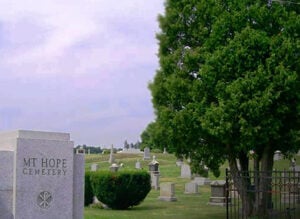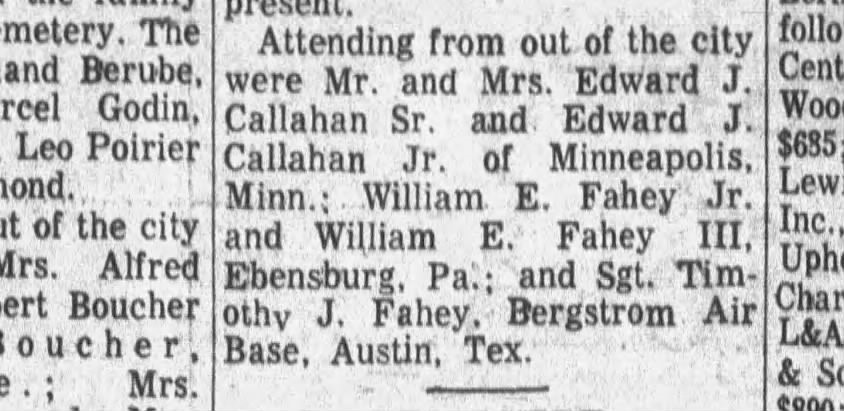The dead charge us with the duty to remember.
I can trace my fascination with genealogy back to a moment in my early childhood, when I first heard the call of the dead. It was January 7 th, 1972, and I was about four and a half years old. We were at the funeral of my great-grandmother Beatrice Frances Callahan Carroll. I could remember her very clearly, sitting in her grand house in front of a roaring fire, playing with very old toys while the adults did dull things. I remember her smile. It was not frequent, but it was very moving when I looked up and saw it, often particularly directed to me as the newest member of the family. Now, there she was in a casket—her, but not her.
My Nanna, a tall and elegant New England woman, put an arm around me—a rare tender moment for her. She wore a fur coat with a leopard pattern, which I thought very wild, while the rest of the adults wore dark colors. She said then the words she would repeat to me a quarter-century later at her husband’s viewing: “I was born in the room above us, and one day will be here."
The funeral home was formerly my Nanna’s father’s home, a once-grand Victorian in Lewiston, Maine which now was moldering away into advanced neglect. She had played and grown up in this very house. It was her brother-in-law who eventually purchased it and turned it into the funeral home.
During that day, there was plenty of talk about family members who had passed. I sat through the Mass and the strange, silent drive to Mt. Hope Cemetery. I did not know what a cemetery was. When we got there, I recall my mother waving her hand slowly at all the graves and markers on a hill, saying, “They are all here. The whole of the family.” I am sure that I was too young to read the gravestones—I was decades and decades away from vital records and family group sheets. But dwelling on the big ideas of life and death, and looking around at the quiet hill crowned with large snow-covered maple trees, I felt the strong presence of all those visibly absent family members. I was not scared, just small.
My family seemed to have been in Maine an awfully long time, from all those graves and all the stories. I would learn later that the Faheys came to the United States in the 1840s, when Michael Fahey left Galway, Ireland to work on the Grand Trunk Railway line between Montreal and Portland, Maine. Michael’s son and my great-great-grandfather, Edmond Francis Fahey, was the one who brought the name to Lewiston. His son married Margaret McKenney, through whom I can trace my Maine relatives back to the early 17 th century. Most of us have lived in the Casco Bay area, especially near Cape Elizabeth and Richmond Island.
That funeral was half a century ago. Now, as November carries us from fall to winter, I find these memories resurfacing. As a Catholic, I spend all of November remembering and praying for the dead, a tradition that we owe to the ancient Hebrew warriors who remembered and prayed for their deceased friends and family.1 Most cultures have ceremonies for the dead which tie together memory, ceremony, history, and spirituality. I think that now is a very good season to share our interest in genealogy, to renew it all and pass the stories on.
I wonder, do genealogists spend enough time tracing the origins of their own thoughts and desires? When I was first working on my genealogical studies certificate, I chuckled to find that the eminent Elizabeth Shown Mills, in her Evidence Explained, did not define the craft of genealogy until you plodded to page 823.2 Of course, Mill’s book is about research methodologies, professional standards, and forms of citation. We do not need nor expect philosophical thought from this handy tome. Yet my question stands: what is genealogy, and why do we do it?
My personal answer is that the tools of genealogy allow me to listen quietly to the voices of the deceased, to expand my knowledge of their lives. Through a recent search using Newspapers.com, I discovered an obituary which filled in the details of my childhood memories. There was my great-grandma Carroll’s face, younger now, smiling a different smile than the one I remember by the fireplace.
Now instead of only an image in my mind, I have a list of interests, associations, and family. Leads to find further stories. Searching through dreary subsets and keywords, I came upon the afternoon edition of the Lewiston Sun-Journal’s for January 7th, 1972. And once again I rediscovered my family, my father, and myself.
Notes
1 The context is the second century military campaigns of Judas Maccabeus, in particular his actions after a great battle in which prayers and sacrifices were made for the souls of the deceased (II Maccabees, chapter 12). As the King James Version elegantly puts it: “For if he had not hoped that they that were slaine should have risen again, it had bin superfluous and vaine, to pray for the dead. And also in that he perceived that there was great favour layed up for those that died godly. It was an holy, and good thought whereupon he made a reconciliation for the dead, that they might be delivered from sinne.”
2 Elizabeth Shown Mills, Evidence Explained: Citing History Sources from Artifacts to Cyberspace (Baltimore, Maryland: Genealogical Publishing Company, 2007).


